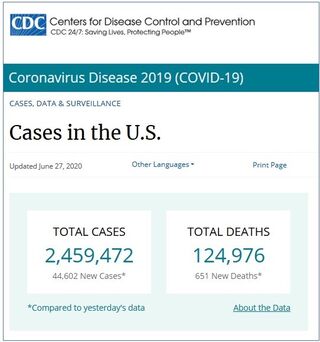Coronavirus Disease 2019
Dear CDC: I Have to Make a Life-and-Death Decision
An 80-year-old mother, a far-away son, and the coronavirus.
Posted June 28, 2020 Reviewed by Kaja Perina
Dear CDC:
Following your advice regarding COVID-19, I have “stayed at home” as much as I can since mid-March. The dozen or so times I’ve had to leave the house – groceries, doctors’ appointments – I’ve worn a mask and social distanced. I’ve been trying to be careful for my own sake as well as that of my family and other people.
Recently, my 80-year-old mother moved to a new home. She’d really like me to come to see it, but I think mostly she’d like me to come to see her. She lives hundreds of miles away, so I haven’t seen her in person since last December. And to be honest with myself and objective about where she is in her life story, I may not have many more opportunities to spend time with her. The average life expectancy in the US is 79 years – she’s on the downside of this curve. But I’m afraid if I go, I’ll be risking her life by unintentionally giving her the disease.
I know from the extensive media coverage the daily count of cases and deaths.
I also know from the regular information you provide that “older adults and people of any age who have serious underlying medical conditions might be at higher risk (emphasis added) for severe illness from COVID-19.” Here are some other conditions you’ve addressed in this regard:
“Having obesity, defined as a body mass index (BMI) of 30 or above, increases your risk of severe illness from COVID-19.”
“Having any of the following serious heart conditions [e.g., heart failure, coronary artery disease] increases your risk of severe illness from COVID-19.”
“Having type 2 diabetes increases your risk of severe illness from COVID-19. Based on what we know at this time, having type 1 or gestational diabetes may increase your risk of severe illness from COVID-19.”
And you’ve reported “increased risks” for a number of other medical issues like smoking, liver disease, asthma, kidney disease, hemoglobin disorders, pregnancy, and neurologic conditions. Your European counterpart, the European Centre for Disease Prevention and Control, speaks in similar terms of “low,” “moderate,” and “high” levels of risk.
But, quite frankly, knowing that there is “increased risk” for certain people is incomplete information at best. What is the number it’s increased from? Likewise, I don’t know from counts of cases and deaths like you and the media often report what my actual risk – or the risk of a typical person – of having the disease is.
If I agreed to visit my mother, is the risk of me having the disease – therefore risking her life – 1 percent? 10 percent? 25 percent? More?
Here’s why this is vital information to have. If the typical person in the US has a one-in-four chance (25 percent) of having COVID-19, then I’m very worried about taking this deadly disease to my mother. Unless there’s an emergency, I’m not going.
On the other hand, if the typical person in the US has a one-in-a-hundred chance (1 percent) of having the disease, then I’m much less worried about me having it and infecting my mother. By my personal risk tolerance regarding my mother, if the risk only gets up to 3 percent or 4 percent, then I’ll discuss that with her and probably go if she still wants me to. At 10 percent, I’m almost certain not to regardless of her desires.
What I’m trying to convey to you is that telling me that risks are “higher” does not tell me what the actual risk is. Telling me the number of cases and deaths or that cases and deaths are “surging” or “spiking” does not tell me if I or someone I love is more likely than not to get the disease and ultimately become very sick or even die from it. So, it does not help me make this life-and-death decision.
I’m left, then, to try to figure this out on my own. I am a quantitatively oriented political scientist who actively publishes in peer-reviewed scientific journals. Although I’m not a public health expert, rigorously analyzing scientific data is something I do, and am expected to do, on an almost daily basis.
So, I can make some non-expert, back-of-the-envelope calculations. According to the screenshot, which comes from your website, as of June 27 there were about 2.5 million confirmed COVID cases and about 125,000 confirmed COVID-related deaths in the US since you started tracking these numbers (presumably since the first case in the US at the end of February, but that’s unclear from the website). I know that the population of the US is about 330 million.

By my rough estimates (dividing the Total Cases and Total Deaths by 330 million), the probabilities of a typical person contracting or dying from the disease is well less than 1 percent over a four-month period. If you look at the New Cases and New Deaths, which represent the numbers in a single day, and which get more closely to my questions, the probabilities are substantially smaller and much closer to 0 than 1 percent.
I realize that my back-of-the-envelope calculations are based on very little information and non-expert analysis. There is a good chance they’re wildly off. And I realize that some people, foolishly and wrongly, may use my informal calculations to justify acting carelessly. I adamantly encourage them not to. These estimates are based on extremely limited information and are overly simplistic. I hope people stay home when they can, and when they can’t that they wear a mask and social distance.
But I also realize these calculations, which place the probability that I’ll expose my mother to this disease at less than 1 percent, put me under tremendous pressure to yield to her request in the absence of better information. It’s unreasonable – and possibly cruel – to say to her “I can’t see you because there’s a less-than-1 percent chance I’ll expose you to the disease.”
CDC (and news media), here are some questions I and innumerable other people faced with these tough decisions need to know to make smart and informed decisions:
What is your fully informed, expert estimate of the probability that a typical person (like me) has COVID-19 right now? Is it 1 percent, 10 percent, 25 percent, or something else?
If a typical person goes to the grocery store today, what is your estimate of the probability the person will contract the coronavirus on this trip? If he or she goes to the typical job, what is the probability the person is going to get COVID-19? If the typical child goes to school, what is the probability he or she will contract the coronavirus?
And from my pure self-interest:
What is the probability a typical person (like me) will die from COVID-19?
This is important information for not only people worried about elderly family members, but also the millions of people facing hard decisions about going back to work, the thousands of business owners trying to decide whether and how to re-open their doors to employees and customers, and the millions of parents trying to decide about sending their children back to school in the fall.
We in the US live in a democracy, one pillar of which is an informed citizenry. And we live in an enlightened society, which idealizes rationality and evidence-based decision making. Yet this basic, objective information is not easily known to us to inform our decisions – these life-and-death decisions. I don’t hear or see it regularly reported, if at all, by you or the media.
I realize that the raw numbers of confirmed cases and deaths are vital evidence to MDs, epidemiologists, and other public health experts. They know when and how to apply them for tracking the disease and helping those potentially exposed to the disease. Further, I realize that is information the media can use in their efforts to inform the public and perform their watchdog function over government, even though at best it is incomplete information. And, unfortunately, I realize that in some skeptics’ minds, this form of media reporting is nothing but the media’s effort to sell more advertising by creating a sense of urgency to attract more people to watch and read their reports.
But information about “increased risk” is not terribly useful to the rest of us, the non-experts, who face real-world, important decisions. Information about raw numbers of cases and deaths is incomplete at best.
Please, CDC, provide the people who fund you, who depend on you, this fundamental information. It is clearly possible. Public opinion and other professional researchers scientifically collect, analyze, and report information from and on people, including health information, on an almost daily basis. Drawing and collecting data from a representative sample of the population is a common activity for social scientists, market research firms, large civic and trade organizations, and, indeed, the CDC and US government.
I need carefully collected, scientific, credible information. Otherwise, I’m left to rely on back-of-the-envelope calculations and widespread public speculation. And too many people in my family – people I love – are involved to depend on that. I have a life-and-death decision to make.
Sincerely,
Gregg Murray




